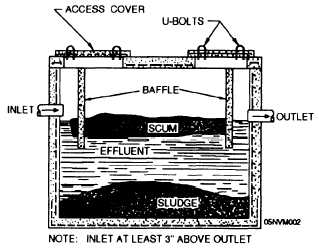SEPTIC TANKS, CESSPOOLS, AND LEACHING FIELDS
Septic tanks, cesspools, and leaching fields are used for sewage treatment processes where common sewers are not available. These facilities are for the most part underground receptacles. If properly designed, constructed, located, and operated, these receptacles work without objectionable odors over long periods of time with a minimum amount of attention.
SEPTIC TANKS
Septic tanks may be used to serve small or scattered installations where the effluent can be disposed of by dilution, leaching wells or trenches, subsurface tile, or artificial subsurface filter systems (fig. 10-2).
The septic tank capacity should equal a full day's flow plus an additional allowance of from 15 to 25 percent for sludge capacity. The minimum acceptable size of septic tank is 1,000 gallons. Table 10-14 outlines the minimum tank capacities required by the National Standard Plumbing Code.
Septic tanks are constructed of reinforced concrete. The length of the tank should be not less than two nor more than three times the width. The liquid depth should not be less than 4 feet for the smaller tanks and 6 feet for the larger ones. Manholes should be provided over the inlet and outlet pipes and over the low points in the

Figure 10-2.-Septic tank
Table 10-14.-Capacity of Septic Tanks

